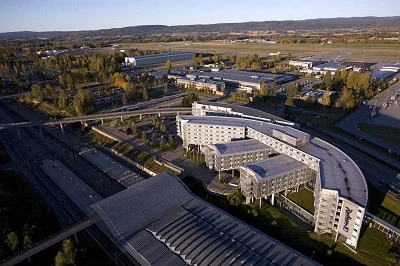Part 3/5: Airports and planes on the sustainability tarmac
Effective climate action can come from outside official bodies. Going beyond words, this 5-part series on tangible climate actions for a green economy shows how non-state actors are hard at work and delivering real results. By Jovin Hurry
PARIS, 16 March 2018. Transport accounts for nearly 18% of all emissions worldwide, and over 90% of the entire sector depends on carbon intensive fossil-fuels. To date, only 3% of transport fuels are low-carbon. According to the International Energy Agency, if we are to satisfy economic growth and limit global warming to below 2 degrees celsius, 10% of all transport fuels must be low carbon by 2030 and 30% by 2050.
Oslo Airport is one of the few carbon neutral operations of its kind worldwide. Courtesy Oslo Airport.
Most of us like to fly in the sky. Not all of us realise that when we take off from an airport and land in another one, the connecting ports consume enormous resources. With some 1.2 billion tourists crossing borders each year, tourism has a profound and wide-ranging impact the environment and the economy. It brings pressures in terms of greenhouse gas emissions, economic leakages, resource management and impact on local communities and cultural assets.
Paris out
But astonishingly, international air transport emissions are not covered in the Paris Agreement Nationally Determined Contributions. The United Nations Framework on Climate Change (UNFCCC) has partnered with the independent and voluntary Airport Carbon Accreditation programme, to assessment participating airports’ efforts to manage and reduce their CO₂ emissions. More than 200 airports are currently certified and 35 airports have reached climate neutrality certification. The central goal of the Paris Agreement is to keep the average global temperature rise below 2 degrees Celsius, hopefully to 1.5 degrees. But about one degree of that rise has already happened, underlining the urgency to progress much further and faster with new technologies.
Last year, Heathrow Airport launched plans to improve sustainability, which include zero carbon infrastructure by 2050, with a ‘centre for aviation sustainability’ reputation fo reducing social and environmental impacts. It is looking at waste as a resource: creating value from waste water and waste materials; in their supply chains; and finding commercial applications for other waste. It also aims to improve the usage of sustainable and low carbon materials for its vast array of buildings and infrastructure, from road surfaces, to floor coverings and building foundations
Copenhagen Airport has adopted green roofs to help minimise its sustainable footprint. Courtesy Copenhagen Airport.
As the centrepoints of a complex web of aircraft movements, airport technical operations and surface transport, airports can address their CO2 emission with a range of options. Better insulation and energy efficiency, using green energy sources, investing in hybrid, electric or gas-powered service vehicles, encouraging public transport usage, working to reduce runway taxiing times and green flight paths. But becoming a sustainability hub is not an overnight task for airports. Heritage infrastructure and processes; old buildings; state owned issues; and above all little awareness of airports being climate neutral all hinder the process.
Read the rest of the articles in this climate action series:
- Part 1 Youths take charge of their future
- Part 2 Businesses ramp up on innovation and collaboration
- Part 4 Climate action with clean energy funding
New Tech
Some airports are using electric vehicles to cut emissions. Courtesy Alaska Airlines.
New mindsets and innovation in the aviation sector have, however, been increasing. Airport Collaborative Decision Making (A-CDM) is one such technology. It uses artificial intelligence (AI) to improve the overall efficiency of airport operations by optimising resources and improving predictability of events. It focuses on operational systems, aircraft turn-round and pre-departure sequencing processes. The bonus is A-CDM brings benefit for all major airport and network operations; it raises both productivity and cost-efficiency, brings more stable traffic flows and reduced taxi times, as well as less congestion and fewer delays.
The Liaoning Ruixiang RX1E can fly two people for two hours using battery power. Courtesy Liaoning Ruixiang.
Airlines are adopting new, greener new tech too. QANTAS, Hainan and Virgin have all initiated the use of blended biofuels. QANTAS has announced that all its Los Angeles-based flights will be powered by biofuels from 2020 onwards. And the Shenyang Aerospace University-developed Liaoning Ruixiang RX1E -A trainer offers a two hour emissions-free flight using only electric propulsion. The advantages that the electric aircraft offer are not limited to zero-emissions travel: they have significantly cheaper running and fuel costs too, with a mere $1.45/hour operating bill, according to one of the designers.
But aviation has a long way to go. Representing some 10% of world GDP, 1 in 10 jobs and 7% of global exports, tourism has a decisive role to play in the achievement of the 2030 Paris Agenda. Airlines and airports will need to push harder for sustainably increasing number of consumers and the increasing ability to travel.



